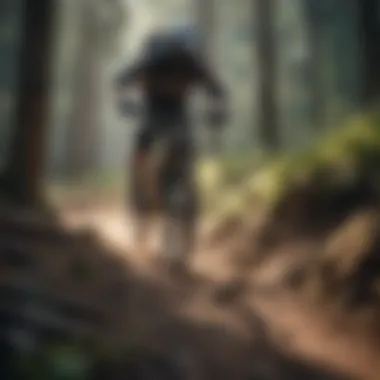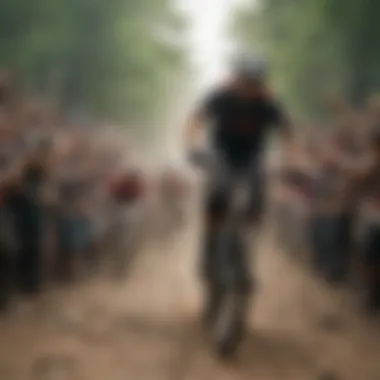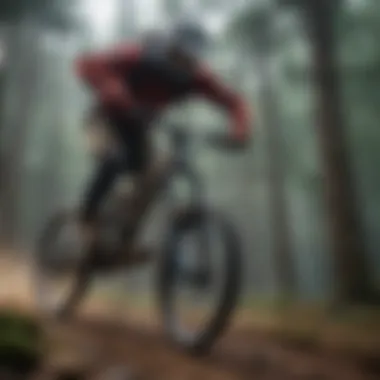Exploring the Mountain Bike Festival Culture and Community


Intro
Mountain bike festivals have grown in popularity, becoming significant events for both participants and spectators. These gatherings are not just about racing and competition; instead, they encapsulate a broader culture and community of cycling enthusiasts. Understanding these festivals helps one appreciate their role in fostering connections among riders while promoting the sport itself.
This article provides a thorough examination of the multifaceted nature of mountain bike festivals, addressing their origins, cultural impact, and competitive aspects. It also serves as a practical guide for those who want to engage in these events, offering insights into essential gear, safety protocols, and overall festival experiences. By analyzing trends within the mountain biking community, we aim to showcase the importance of festivals in enhancing the thrill-seeking experience.
Techniques and Tips
Engaging in mountain bike festivals can be exhilarating, but it also requires preparation and understanding the nuances of the sport. Here are some valuable techniques and strategies to consider.
Skill Development
Building skills is crucial for any aspiring mountain biker. Focus on improving your handling techniques, climbing ability, and descending control. Attend workshops or clinics available at the festival to refine these skills. Practicing on varied terrain can also build confidence.
Practical Techniques
- Body Positioning: Maintain a balanced body position to navigate obstacles with greater ease. Keep elbows bent and slumped slightly to absorb shocks.
- Braking: Mastering your braking technique is essential. Use both brakes evenly, with a slight preference for the rear brake in most situations.
- Line Choice: Choosing the right line can make or break an off-road ride. Always be aware of the terrain and anticipate conditions ahead.
Common Mistakes to Avoid
- Overexerting yourself is a common issue. Pace yourself to enjoy the ride.
- Neglecting equipment maintenance can lead to performance issues.
- Skipping pre-ride warm-ups can increase the risk of injury.
Gear and Equipment
The right gear significantly affects your performance during mountain bike festivals. Here is a detailed look at essential equipment and recent innovations.
Essential Gear for Beginners
For those new to mountain biking, investing in the right gear is crucial. A sturdy mountain bike is fundamental, along with comfortable cycling shorts and a reliable helmet. Other essentials include:
- Gloves: Provides grip and protects your hands.
- Shoes: Proper shoes offer better control and comfort during rides.
- Hydration Packs: Staying hydrated is vital, so consider a pack that allows for easy access to water.
Latest Innovations and Trends
Recent advancements have led to better materials and technology in mountain biking gear. Lightweight carbon frames have become popular, along with tubeless tire technology to reduce punctures. Monitoring systems in helmets and bikes provide safety and performance information on the go.
Reviews and Comparisons
When choosing gear, consult reputable sources for reviews. Websites like Reddit provide valuable community insights. Comparing equipment can save time and money while ensuring you select high-quality products.
Safety Measures
Safety is paramount in extreme sports, particularly mountain biking. Implementing proper safety protocols can prevent accidents and injuries.
Essential Safety Gear
Key pieces of safety equipment include:
- Helmets: A well-fitted helmet is a must.
- Pads: Elbow and knee pads provide cushioning and protection against falls.
- Reflective Gear: If biking in low-light conditions, wear reflective gears for visibility.
Best Practices for Safe Participation
- Always inform someone of your planned route and expected return time.
- Ride within your skill level. Don't push beyond your limits in a competitive environment.
- Be mindful of the trail and other riders. Communicate effectively on the trail using basic signals.
Injury Prevention and Management
Injuries can occur even with precautions. To manage this:
- Warm-up properly before rides.
- Listen to your body if you experience pain. Rest as needed.
- Have a first-aid kit handy and know basic first-aid procedures for common injuries.
Spotlights on Extreme Sports


Celebrating extreme sports not only enhances community spirit but also raises awareness of the athletes involved. Here are some areas to consider.
Featured Sport of the Month
Each month, different mountain biking disciplines gain focus. This builds excitement and interest within the community. Activities like downhill racing or cross-country can take center stage.
Profiles of Prominent Athletes
Highlighting athletes offers inspiration. Many world-class riders participate in these festivals, showcasing their skills. Learning from their experiences can help aspiring bikers develop their own paths in this thrilling sport.
Foreword to Mountain Bike Festivals
Mountain bike festivals represent a unique confluence of sport, culture, and community. These gatherings go beyond mere athletic competition; they are expressions of passion and dedication to the biking lifestyle. For enthusiasts, the festivals serve as a stage to showcase talent, share knowledge, and foster connections, making them a pivotal aspect of the mountain biking ecosystem. This introduction aims to uncover the fundamental elements of mountain bike festivals, elucidating their role in promoting the sport and building camaraderie among riders.
Defining Mountain Bike Festivals
Mountain bike festivals can be broadly categorized by several core aspects. At their essence, they are events that celebrate mountain biking through various activities, including races, exhibitions, and workshops. These festivals often feature competitive racing in several formats, such as cross-country and downhill events, attracting skilled riders of diverse levels. The presence of vendors offering the latest biking gear, along with interactive workshops, empowers participants to enhance their skills and knowledge. Such diverse offerings create an atmosphere of learning and competition, appealing to both spectators and participants alike.
Typically held in picturesque locations, these events not only highlight the beauty of mountain trails but also promote environmental awareness among attendees. As such, mountain bike festivals play a crucial role in inspiring the biking community to respect and preserve nature while enjoying their adventurous pursuits.
Historical Context
The origins of mountain bike festivals can be traced back to the evolution of the sport itself. Emergence of mountain biking in the late 1970s and early 1980s laid the groundwork for a culture that celebrated outdoor activity and communal trials. Early enthusiasts in California pioneered the movement, creating a sense of community that persists today.
As the sport gained traction, events were organized not just as races but as opportunities for followers to share their experiences and connect with one another. Over the years, the festivals have evolved significantly, resulting in an influx of sponsors, professional riders, and expansive audiences. This escalation has made mountain bike festivals a vital component in developing local economies while serving as a source of inspiration and motivation for riders at all levels.
"Mountain bike festivals are more than competitions; they embody a lifestyle, a community, and a commitment to adventure. They inspire riders to push their limits in a collaborative, supportive environment."
In summary, the significance of mountain bike festivals cannot be underestimated. They act as a cornerstone for fostering community within the biking world while celebrating the culture and competitiveness that define this exhilarating sport.
Cultural Significance
The cultural significance of mountain bike festivals extends beyond mere sporting events; they are pivotal gatherings that showcase the intricate tapestry of the mountain biking community. These festivals celebrate the spirit of adventure, encouraging enthusiasts to come together and share their passion for cycling and the outdoors. The exchange of ideas, stories, and skills at such events fosters a sense of belonging, threading a common culture among participants. For thrill-seekers and extreme sports lovers, these gatherings transcend competition, evolving into experiences rich with camaraderie and creativity.
Impact on the Mountain Biking Community
Mountain bike festivals play a crucial role in strengthening the mountain biking community. They serve as a platform for riders of all skill levels to connect, learn, and grow. This interaction is vital for both seasoned riders and newcomers alike. By participating in festivals, individuals gain access to a wealth of knowledge and the chance to build relationships with others who share their passion.
Furthermore, these events contribute to the community through partnerships with local businesses and sponsors. Vendors at festivals promote cycling-related products and services, reinforcing economic ties and community support. The networking opportunities available foster collaboration, resulting in new trails, riding clubs, and events fueled by local enthusiasm.
Crossing Boundaries: Art, Music, and Bike Culture
Mountain bike festivals are a vibrant convergence of art, music, and cycling culture. They often feature local artists displaying their work, contributing to the festival's visual appeal. Art installations inspired by nature and cycling unite participants around common interests, creating shared experiences.
Moreover, live music acts add an electrifying atmosphere, transforming the festival into a celebration of life and adventure. The sound of music combined with the sound of bikes tearing through trails sets a unique backdrop, engaging all senses. Such elements emphasize the intersection between biking and broader cultural expressions, making these festivals not only a showcase of athleticism but also of artistic creativity.
"Mountain biking is not just a sport; it’s a lifestyle, a culture, and a means to connect with like-minded individuals."
These multifaceted interactions enrich the mountain biking experience and promote a culture that appreciates outdoor adventure and the arts. In this way, mountain bike festivals act as cultural incubators, expanding the reach and appreciation of biking while keeping the sense of community vibrant and inclusive.
Elements of a Mountain Bike Festival
The significance of elements found at mountain bike festivals cannot be underestimated. These components are not only essential for the participants but also enhance the overall festival environment. From competition formats to interactive spaces, each element contributes to an immersive experience that strengthens community ties and promotes the sport itself. Understanding these elements provides insight into how festivals operate and the unique benefits they offer.
Race Formats and Competitions
Race formats in mountain bike festivals are diverse and tailored to various skill levels. Some events feature cross-country races, which test endurance on mixed terrain. Downhill competitions, often breathtaking, challenge athletes to navigate steep descents at high speeds. Other styles, like enduro racing, combine both climbs and descents, demanding a wide range of skills. The format chosen often influences participant enthusiasm, attracting riders who are keen to test their abilities against the clock or fellow competitors.
Additionally, competitive events foster a sense of camaraderie among riders. Participants cheer for each other, share tips on courses, and celebrate victories, regardless of personal outcomes. This collaborative spirit enhances the festival atmosphere, pushing individuals to pursue excellence while forming bonds with like-minded enthusiasts.
Exhibitions and Vendor Areas


Exhibitions and vendor areas play a pivotal role in mountain bike festivals. These sections serve as hubs for interaction, where brands showcase the latest gear and innovations in the industry. Vendors present bicycles, accessories, and performance gear that are crucial for any serious cyclist. Attendees can explore products and engage with company representatives, allowing for informed purchasing decisions.
Beyond shopping, these areas promote local businesses and craftspeople, further entwining the festival with its community. Food stalls provide local flavors, often highlighting regional culinary delights. This interaction is beneficial for both vendors and festival-goers, creating an experience that goes beyond mere competition.
Workshops and Skill Development
Workshops at mountain bike festivals offer valuable learning experiences. From beginner clinics to advanced technical skill sessions, these educational opportunities cater to a wide audience. Knowledgeable instructors guide participants in learning new tricks, improving techniques, and increasing safety awareness.
Skill development is critical not just for riders but also for enhancing the community. Participants who leave with new abilities are likely to encourage others, fostering a supportive environment that prioritizes growth. The workshops also provide avenues for networking, connecting riders who share similar interests and enhancing the communal aspect that defines these festivals.
"Mountain bike festivals are not only about racing; they are a celebration of community and shared passion for the sport."
These elements of a mountain bike festival create a rich tapestry that attracts thrill-seekers and leisure riders alike. By emphasizing competition, showcasing industry innovations, and providing essential skill development, festivals establish themselves as vital events in the mountain biking culture. Understanding these aspects is key to appreciating their multifaceted nature and significance.
The Experience of Attending a Mountain Bike Festival
The experience of attending a mountain bike festival extends beyond the physical act of riding. It encapsulates a unique blend of identity, culture, and community engagement. For thrill-seekers and adventure lovers, these events provide an atmosphere rich with excitement and camaraderie. Engaging with other enthusiasts is more than just a social aspect; it fosters a sense of belonging within the broader mountain biking community.
Pre-Festival Preparations
Preparation is essential when attending a mountain bike festival. Enthusiasts should consider the following elements:
- Research the Event: Understand the schedule, trails available, and various activities planned.
- Gear Check: Ensure that your mountain bike is in excellent working condition. It's also wise to pack essential tools for minor fixes.
- Clothing and Accessories: Given the unpredictable nature of weather in mountainous regions, layering is advisable. Don't forget sunscreen and protective gear.
- Accommodations: Depending on the festival's location, booking nearby lodgings or camping spots in advance can enhance your experience.
By taking these steps, attendees ensure they maximize their enjoyment while minimizing potential stresses during the festival.
On-Site Experience: What to Expect
Arriving at a mountain bike festival is a sensory experience. One can expect the following:
- Vivid Atmosphere: The sounds of bikes, the chatter of excited attendees, and the smell of fresh mountain air creates an energizing environment.
- Competitions and Races: Spectators can watch skilled riders showcase their talent through various race formats like downhill, cross-country, or enduro races.
- Workshops and Exhibitions: Many festivals offer workshops targeting skill levels from beginner to advanced. Exhibitor booths often feature the latest gear and innovations in mountain biking.
- Social Activities: Engage with other attendees at social events. Evening gatherings often include music, food vendors, and opportunities to meet industry professionals.
These aspects contribute to a vibrant community, where connections flourish and friendships form.
Post-Festival Reflections
The experience does not end when the festival concludes. Post-festival reflection is key for many attendees. They might consider:
- Lessons Learned: Skills gained from workshops or competitions can be invaluable. Reflecting on personal performance can inspire further growth.
- Community Interaction: Engaging on social media platforms like Facebook or Reddit allows for ongoing connections.
- Future Goals: Attendees often feel invigorated to set new ambitions for their biking journey after participating in such dynamic surroundings.
"Attending a mountain bike festival is not just about the bikes and racing; it’s about the moments shared with others who understand your passion."
The impact of these events resonates long after they conclude, reinforcing connections and sparking motivation within the biking community.
By approaching mountain bike festivals with the right mindset and preparation, participants can create lasting memories and contribute to the atmosphere of this vibrant culture.
Safety Considerations
Understanding safety considerations is critical at mountain bike festivals. These events can attract participants of various skill levels, from beginners to seasoned pros. It becomes essential to ensure that safety protocols are in place to minimize risks and enhance the experience for everyone involved. Proper planning and adherence to guidelines can prevent accidents and promote a positive atmosphere. In this section, we will explore the essential gear participants should have and the health and safety guidelines that organizers must communicate effectively.
Essential Gear for Participants
Participants must equip themselves with proper gear before taking on the trails. Each piece of equipment serves a specific purpose, significantly impacting safety and performance. Here are some essential items:
- Helmet: A high-quality helmet is crucial for head protection. Ensure it fits well and conforms to safety standards.
- Gloves: These protect your hands while providing grip and comfort. Full-fingered gloves are preferable for better protection.
- Protective Pads: Knee and elbow pads are highly recommended. They reduce the impact during falls or collisions.
- Footwear: Sturdy shoes with good traction enhance stability and control, minimizing the risk of slipping.
- First Aid Kit: Accidents can happen, so carrying a basic first aid kit is always wise. It should include adhesive bandages, antiseptic wipes, and other useful items.
- Water Bottle: Staying hydrated is vital, especially when traversing challenging terrain.
This gear not only enhances comfort but also significantly lessens the chances of injury during rides or races.
Health and Safety Guidelines
Health and safety guidelines are equally important for participants. Organizers should establish clear protocols to follow. Here are several key practices to consider:


- Pre-Ride Briefing: Conduct a briefing to familiarize participants with the trails and highlight potential hazards.
- Trail Etiquette: Participants should be educated about respecting trail rules. Yielding to hikers and slower cyclists helps prevent accidents.
- Buddy System: Encourage riders to pair up when navigating trails. Having someone nearby can greatly assist in case of emergencies.
- Emergency Contacts: Organizers should provide clear information on whom to contact for help. A visible sign with contact details for medical assistance should be posted around the venue.
- Monitor Weather Conditions: Changes in weather can affect safety. Participants should be kept informed about any significant weather changes.
Organizing a festival requires a commitment to safeguarding participants without stifling the excitement that these events generate. Ensuring an adequate focus on safety guarantees everyone will enjoy their mountain bike festival experience.
Impact on Local Communities
Mountain bike festivals do not merely serve as a stage for sport; they are catalysts for local community developments. These events integrate various aspects that enrich the community, from economic stimulation to social cohesion. Each festival creates a unique opportunity to showcase the region while engaging local residents and businesses, which is critical for both participants and the community at large. The festival atmosphere can enhance local pride and identity, fostering a collective spirit that unites both residents and visitors.
Economic Benefits
Mountain bike festivals lead to significant economic inflows for local communities. Participants and spectators alike require accommodations, food, and entertainment. Local hotels, restaurants, and shops experience noticeable spikes in business during these events. A study indicated that mountain biking enthusiasts can generate high daily expenditures due to their passion for the sport.
- Job Creation: Festivals often require additional staffing for logistics, guiding, and services. This can lead to temporary job opportunities for community members.
- Tourism Boost: Attracting visitors from various regions can create a long-term interest in the area, enhancing future tourism prospects.
- Infrastructure Development: The need for better access routes, rest areas, and facilities often leads to improvements in the local infrastructure that can benefit the community beyond the festival.
These benefits combine to create a significant economic impact, which is vital for sustaining local businesses.
Community Involvement and Support
Engagement is a key theme at mountain bike festivals. Local involvement enhances the festival experience while ensuring the community reaps lasting benefits.
One aspect is volunteering. Local residents often volunteer their time to assist with various tasks, from providing information to managing events. This fosters a sense of ownership and pride within the community. Involvement can also extend beyond labor; communities can participate through sponsorships or partnerships with local businesses.
- Collaborative Projects: Festivals can initiate joint ventures among local artists, entrepreneurs, and bike enthusiasts. These projects can help promote local culture while engaging a broader audience.
- Educational Opportunities: Programs or workshops at festivals can inform attendees about local ecosystems, trail safety, and maintenance of bike trails. This educational angle fosters respect for nature and responsible biking habits.
- Support for Local Charities: Many festivals partner with charities, using proceeds to fund local causes. This not only raises money but also builds community bonds.
"The local community’s active participation in the festival enhances its authenticity, ensuring that both visitors and residents feel connected to the event."
In essence, mountain bike festivals serve as powerful instruments for economic development and social unity. They can transform how communities view their identity, changing the landscape of local culture while fostering sustainable relationships between residents and visitors.
Trends and Innovations in Mountain Biking Festivals
The evolution of mountain biking festivals reflects broader trends within the outdoor and sporting communities. These festivals are not only gatherings of extreme sports enthusiasts but forums that showcase the latest innovations and evolving priorities in the sport. Understanding the current trends is essential for both participants and organizers as they navigate a rapidly changing landscape.
Sustainability Practices
In recent years, sustainability has become a primary concern at mountain bike festivals. Events now prioritize eco-friendly initiatives. These practices help protect the natural environments where festivals are held and promote a culture of responsibility among riders. Options such as waste reduction, recycling programs, and the sourcing of local food vendors play a crucial role.
Many festivals now offer incentives for attendees who arrive by bike or carpool, promoting a lower carbon footprint. For example, parking fees may be waived for those who use public transport or bikes. This shift towards sustainability not only enhances the festival experience but also attracts a more conscious audience who value environmental considerations.
Benefits of Sustainability Practices:
- Improved community relations
- Enhanced participant experience through clean and well-maintained venues
- Long-term viability of festival locations
Integration of Technology
Technology has greatly impacted mountain bike festivals, bringing about advancements that enhance both the competitive and participatory experiences. Real-time tracking systems, for instance, allow spectators and participants to monitor race progress conveniently. Many events feature apps where users can access schedules, maps, and even live updates.
Additionally, augmented reality (AR) experiences are becoming more common. These innovations provide educational content and entertainment, enriching participants’ understanding of the sport. Vendors are also using technology to offer better gear and services. Smart helmets, equipped with navigation systems and communication tools, are part of this technological evolution.
Considerations for Technology Integration:
- Ensure user-friendliness of apps and software
- Provide adequate technical support during events
- Monitor data privacy and security for users
"As mountain biking continues to grow, the integration of sustainability and technology will play a fundamental role in shaping future festivals."
Overall, trends and innovations at mountain biking festivals represent a dynamic interplay of culture and modernity. Staying abreast of these developments is essential for all involved, fostering a vibrant atmosphere that honors tradition while embracing the future.
Ending
It is essential to understand the importance of mountain bike festivals as they represent more than mere gatherings of enthusiasts. These festivals are pivotal in shaping the identity of the mountain biking community. Through races, workshops, and social interactions, these events foster a sense of belonging among participants. They also serve as a platform for dialogue about the sport and its future, paving the way for innovation and progress.
Reflecting on the Future of Mountain Bike Festivals
Looking ahead, mountain bike festivals are likely to evolve in response to changing trends in sports, technology, and environment. As sustainability becomes more significant, festivals will adapt by incorporating eco-friendly practices. For instance, using biodegradable materials in vendor stalls and promoting responsible behavior among participants can have lasting impacts.
In addition, the integration of technology will redefine how festivals operate. From online registrations to real-time race tracking, technology enhances the experience for both participants and spectators. This could also include virtual reality experiences or live-streaming events to engage even wider audiences.
The role of community should not be overlooked, as it will remain a cornerstone of future festivals. More local involvement can elevate the cultural significance of events, ensuring they resonate with regional identity. Engaging local artists, musicians, and inventors can enrich the overall atmosphere and promote a diverse cultural experience.
As mountain bike festivals continue to adapt, the evolving landscape of extreme sports will undoubtedly shape their future, ensuring they remain relevant and exciting for all.







